12 Couples Yoga Poses to Try With Your Partner

It’s no surprise that yoga has countless benefits for mind, body and spirit. You may already know how couples yoga poses scientifically elevate your mood and boosts overall fitness.
Why not share these benefits with your partner? We bring 12 couples yoga poses to try with your partner to strengthen your relationship and your core!
Couples Yoga Benefits: Stretch, Relax and Unwind With Your Partner
Yoga, as we all know, is an age-old practice which promotes overall well-being. Scientifically, yoga has several benefits:
Yoga enhances strength, flexibility, and endurance, [1] resulting in improved posture, balance, and body awareness.
Regular yoga practice with your partner lengthens muscles and improves joint mobility [2] to protect you and your partner from injuries.
Yogic breathing techniques improve lung capacity [3], respiratory efficiency, and body oxygenation so couples feel more active all day long.
Yoga activates the body’s relaxation response and suppresses stress hormone production to promote a calmer state of mind.
Yoga reduces anxiety and depression [4] symptoms. It elevates your partner’s mood, self-esteem, and overall mental resilience.
Just like your love, yoga is good for your partner’s heart (quite literally)! [5]
Since yoga is an aerobic exercise, it lowers blood pressure, improves lipid profile, and reduces the risk of heart disease. Moreover, it aids chronic pain relief, boosts immunity and improves sleep quality.
If you have a spare yoga mat lying around in your home, it’s time to bring it out and try yoga poses with your partner.
Easy Couples Yoga Poses:
Partner Breathing
How to Do It
- Sit in a comfortable, cross-legged position with your backs resting against each other.
- Place your hands on your thighs or knees and take a moment to connect with your partner.
- Observe your breath, focusing on the sensation of the back of your ribcage against your partner’s.
- Practice for three to five minutes.
Partner breathing is a calming and effective way to centre yourselves and experience a deeper connection. It promotes relaxation and serves as a great starting point for your couple’s yoga practice.
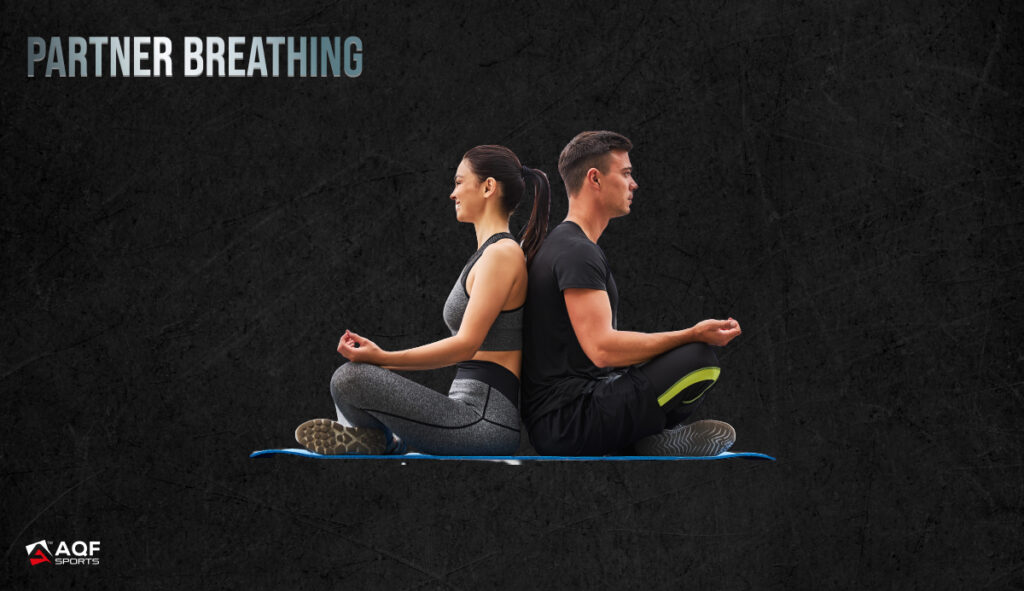
Partner Forward Fold
How to Do It
- Stand back-to-back with your partner, allowing your spines to touch.
- As you exhale, bend forward at the hips, and extend your hands down your legs.
- Keep your knees slightly bent if needed and allow your upper bodies to fold forward together.
- Feel the stretch in your hamstrings and lower back, and support each other’s weight.
This pose promotes a gentle release of tension in the back and hamstrings while fostering a sense of closeness and trust.
Tip:
If you have limited flexibility, you can use a yoga belt to reach your feet. Loop the belt around your feet and hold onto it with both hands. It will keep your spine straight during the forward fold.

Seated Twist (Ardha Matsyendrasana)
How to Do It
- Sit facing each other with your legs extended.
- Bend your right knee and place your right foot on the outside of your left thigh.
- Wrap your left arm around the outside of your right leg and hold your partner’s right hand.
- As you inhale, lengthen your spine, and as you exhale, twist gently to the right, looking over your right shoulder.
- Repeat on the other side.
Seated twists improve spinal mobility, and digestion, and relieve tension in the lower back.
Tip:
You can use a yoga belt to deepen the twist. Loop the belt around your torso and hold onto it with both hands. Gently pull and deepen the twist while maintaining proper alignment.
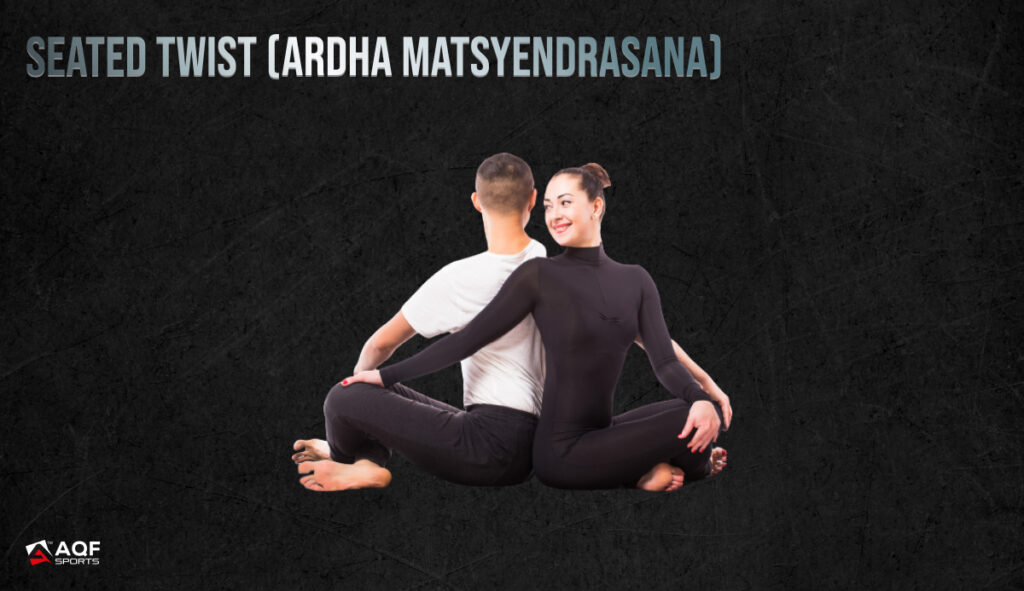
Backbend/Forward Fold
How to Do It
- Sit back-to-back with your legs crossed with your partner, communicating who will perform the forward fold and who will do the backbend.
- The person folding forward extends their hands forward and rests their forehead on the mat or uses a block for support. The person doing the backbend leans back onto their partner’s back, opening the front of their heart and chest.
- Breathe deeply and feel each other’s breaths.
- Stay in the pose for five breaths, then switch positions when you are ready.
This combination of backbend and forward fold provides a balance of stretching and strength. It prepares the body for more advanced poses and fosters a deeper sense of trust and support.
Tip:
In the forward fold variation, you can use a yoga belt to extend your reach. Loop the belt around your feet and hold onto the belt ends to reach forward and deepen the stretch.
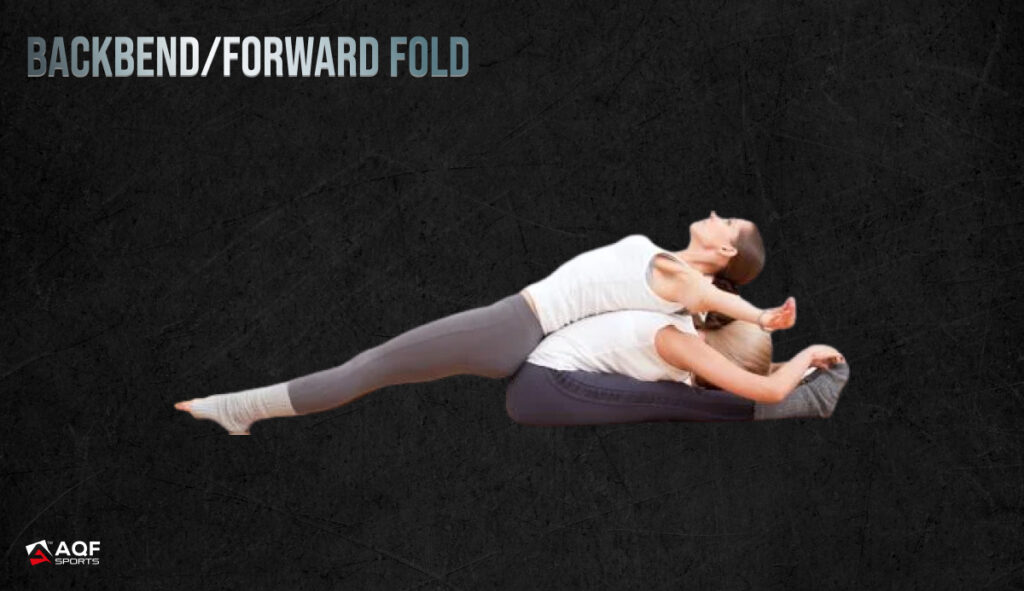
Standing Forward Fold
How to Do It
- Start in a standing position, face away from your partner, and place your heels about six inches apart.
- Bend forward, extending your hands behind your legs and hold the front of your partner’s shins.
- Hold the position for five breaths, then release.
This pose allows you to deepen your forward fold with the support of your partner, promoting a greater stretch in the hamstrings and a sense of connection and trust.
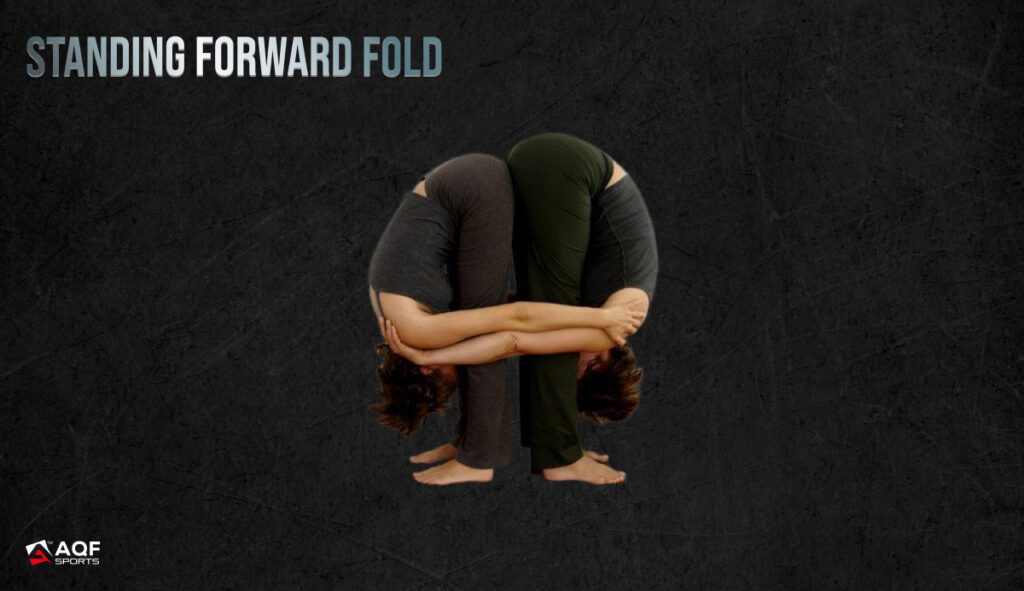
Partner Savasana
How to Do It
- You and your partner will Lie flat on your backs, hand in hand and facing each other.
- Allow yourselves to relax on the floor.
- Stay in this pose, completely let go, and relax for five to ten minutes.
Partner Savasana is a restorative pose that promotes deep relaxation, stress relief, and calmness. It enhances the bond between partners and shares rejuvenation and peace.
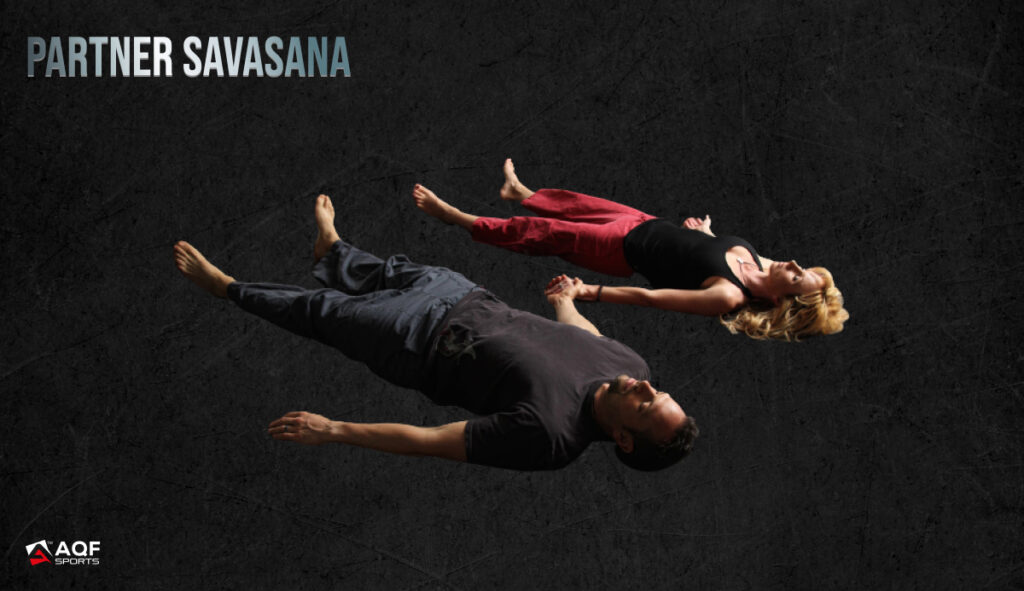
Intermediate Couples Yoga Poses:
Temple Pose
How to Do It
- Stand facing each other with your feet hip-width apart.
- Inhale as you extend your arms overhead, and then bend forward at the hips, meeting hands with your partner.
- Slowly bend more, allowing your elbows, forearms, and hands to rest against each other.
- Maintain equal weight distribution between you and your partner.
- Hold for five to seven breaths, then walk toward each other, bringing your torsos upright and releasing your arms down.
The Temple pose opens the shoulders and chest, preparing your upper body for more challenging poses. It promotes a sense of physical and emotional connection with your partner.
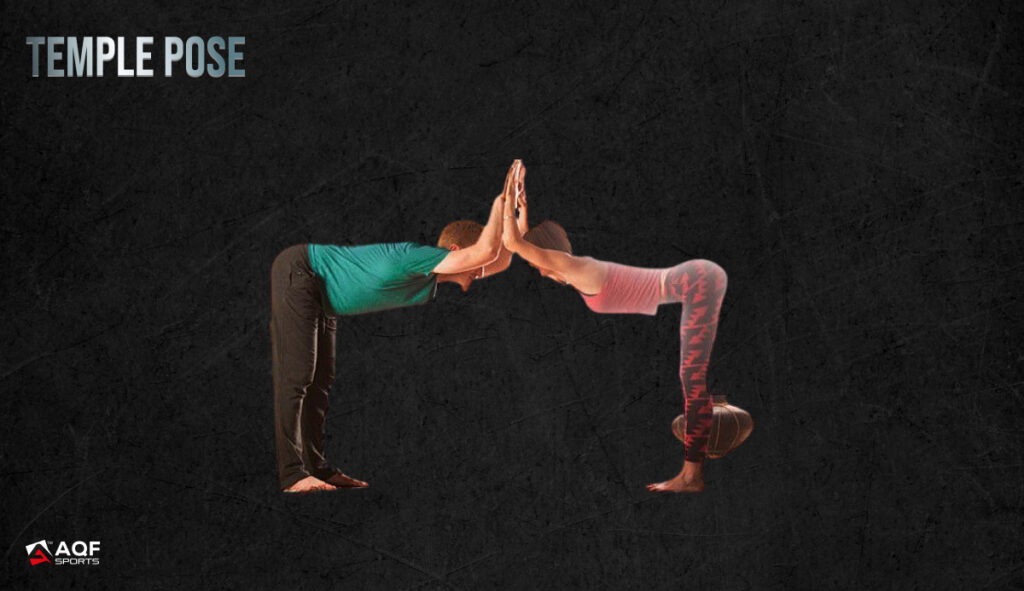
Double Boat Pose
How to Do It
- Sit facing each other, with your knees bent and feet flat on the ground.
- Hold each other’s forearms for stability.
- Lean back slightly, balance on your pelvic bones, and lift your feet off the ground.
- Straighten your legs, bringing your shins parallel to the floor, creating a “V” shape with your bodies.
This pose strengthens the core, improves balance, and promotes mutual support and teamwork.
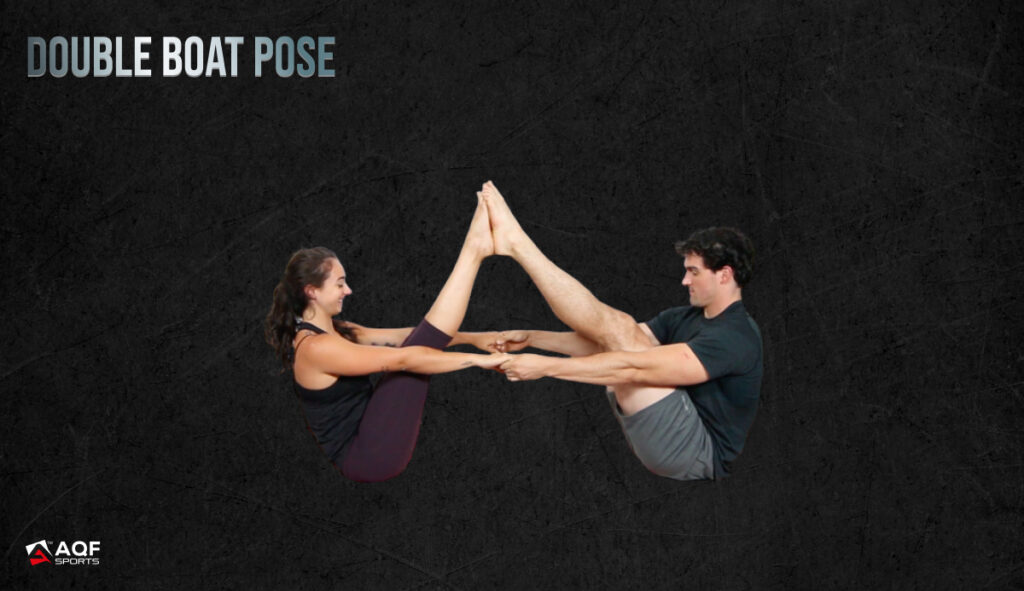
Partner Seated Backbend
How to Do It
- Sit back-to-back with your partner, with your legs crossed.
- Place your hands on your thighs or knees for support.
- As you inhale, lengthen your spine and lift your chest, arching gently backwards.
- Encourage your partner to do the same, and support each other from the back.
This pose opens the chest and shoulders, improves posture, and stimulates energy flow.
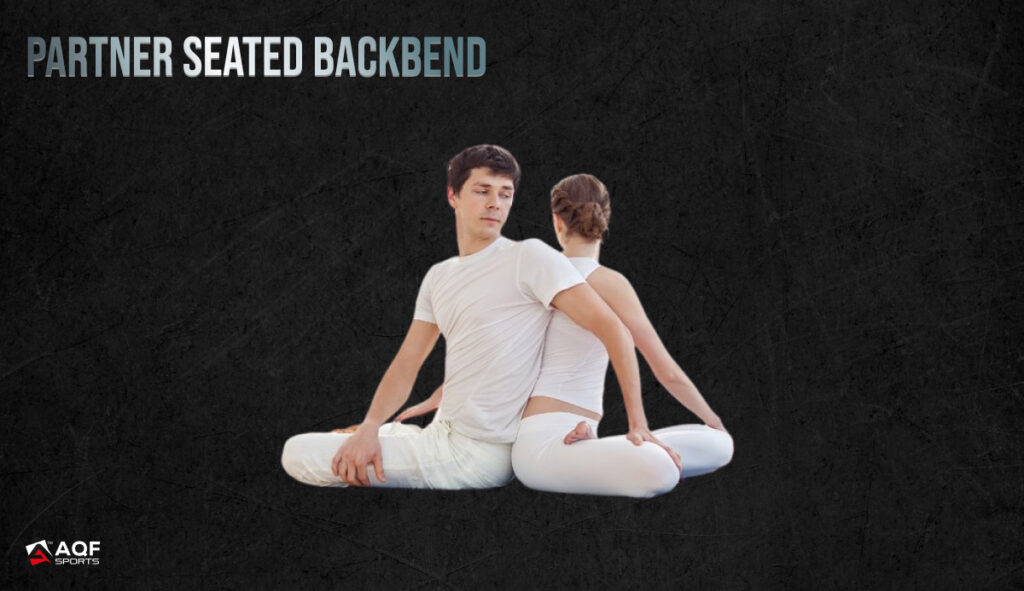
Hard Couples Yoga Poses:
Double Downward Dog
How to Do It
- Start in a modified downward dog pose, facing each other.
- Extend your hands forward and create space between your arms and torso.
- Lift your hips and straighten your legs, forming an inverted V shape.
- Encourage each other to find stability and alignment in the pose.
Double downward dog strengthens the arms, shoulders, and core while providing a stretch for the hamstrings and calves.
Tip:
You can use a yoga belt to align your posture with your partner. Loop the belt around your partner’s hips and hold onto the ends to support and encourage them to maintain proper alignment.
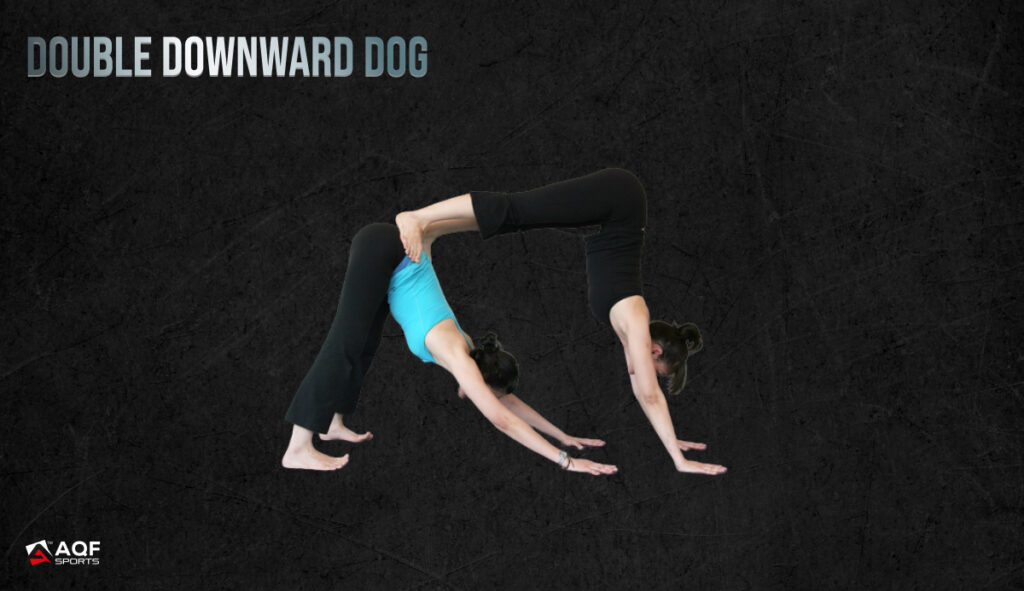
Double Plank
How to Do It
- One partner will start in a plank position, with wrists aligned under the shoulders and engage the core.
- The other partner faces the feet of the first partner and comes into a plank position as well.
- Maintain a strong and straight alignment in the plank, supporting each other’s stability.
- Hold the pose for a few breaths, then slowly release.
The double plank strengthens the core, arms, and shoulders. It improves stability, builds upper body strength, and encourages teamwork and mutual support.
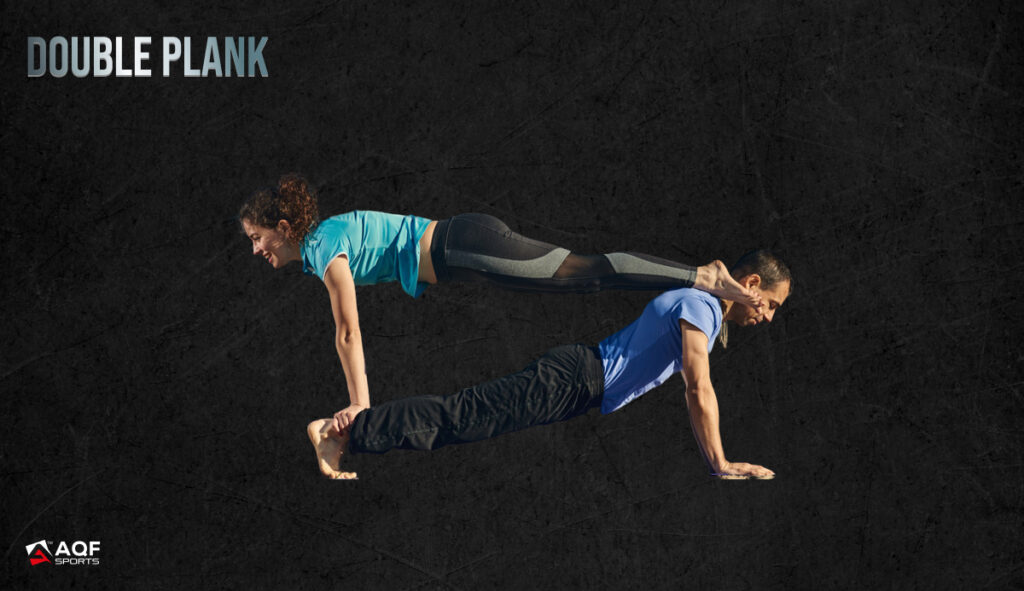
Twin Tree Pose
How to Do it
- Start by standing next to each other and looking in the same direction.
- Stand a few feet apart, bring your inner palms together and extend them upwards.
- Bend one leg and place the foot on the inner thigh or calf of your standing leg.
- Find balance and stability, and hold the pose for five to eight breaths. Then, switch sides.
The twin tree pose enhances balance, concentration, and stability. It strengthens the legs, improves coordination, and cultivates a sense of unity and support between partners.
Tip:
If you or your partner have difficulty balancing in the pose, you can use a yoga belt as a support prop. Loop the belt around your partner’s waist and hold onto the ends while assisting each other to find balance and stability.
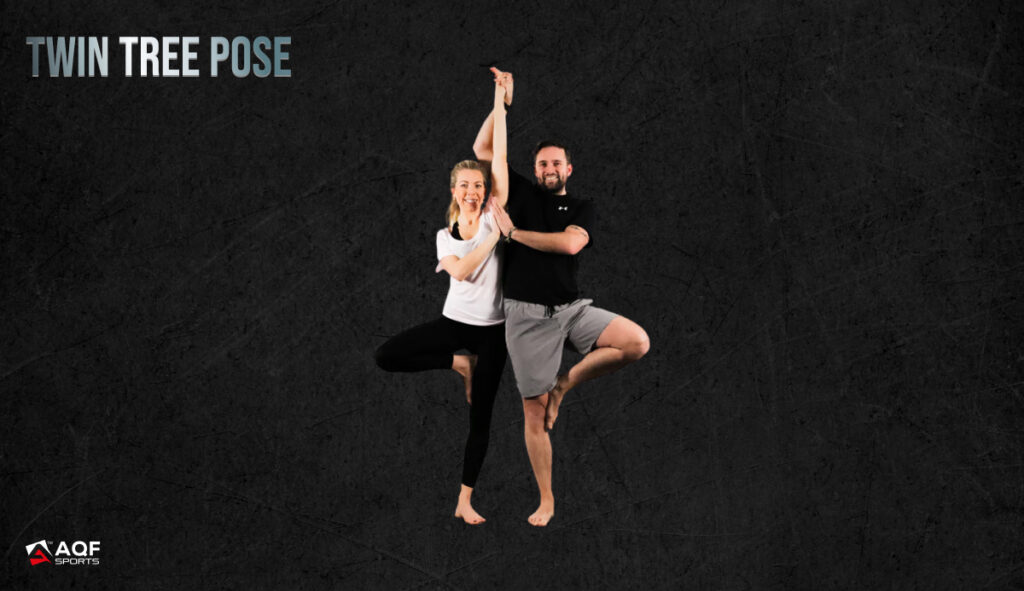
Couples Yoga – FAQs
What is intimate couples yoga called?
Intimate couples yoga is often referred to as Partner or Acro Yoga.
Do couples do yoga together?
Yes, many couples practice yoga together as a way to bond, connect, and support each other in their wellness journey.
How to do tantric yoga with a partner?
Tantric yoga involves specific practices that go beyond physical postures and incorporate meditation, breathwork, and energy connection. It is recommended to seek guidance from a qualified tantric yoga teacher or practitioner for instructions on practising tantric yoga with a partner.
Is there sensual yoga?
Sensual yoga is not a recognized mainstream term in traditional yoga practices. However, certain styles or practices may incorporate elements of sensuality or body awareness. It’s important to clarify intentions and boundaries when exploring such practices.
Do girls like guys who do yoga?
Many people appreciate partners who prioritize self-care, health, and mindfulness. Yoga can be attractive to individuals regardless of gender.
What is tantric yoga?
Tantric yoga is a holistic practice that originated from ancient Indian traditions. It involves integrating physical postures, breathwork, meditation, and energy practices to facilitate personal and spiritual growth, deep connection, and awakening. It often focuses on embracing the divine energy within oneself and cultivating a profound connection with others and the universe.
The Bottomline
It’s quite easy to get busy in your everyday routine – but that doesn’t mean you can’t enjoy quality time with your partner. Couples yoga is an effective way to strengthen mental, physical and spiritual fitness and your partner deserves it just as much as you do. Next time when you are doing yoga, invite your partner to share in the experience as you try these couples’ yoga poses.
Also Read: 5 Must-Know Yoga Stretches for Beginners
References:
[1] Polsgrove, Mj., Eggleston, B., & Lockyer, R. (2016). Impact of 10 weeks of yoga practice on flexibility and balance of college athletes. International Journal of Yoga, 9(1), 27. https://doi.org/10.4103/0973-6131.171710
[2] Kan, L., Zhang, J., Yang, Y., & Wang, P. (2016). The Effects of Yoga on Pain, Mobility, and Quality of Life in Patients with Knee Osteoarthritis: A Systematic Review. Evidence-Based Complementary and Alternative Medicine, 2016, 1–10. https://doi.org/10.1155/2016/6016532
[3] Mane, A., Paul, Cn., & Vedala, S. (2014). Pulmonary functions in yogic and sedentary populations. International Journal of Yoga, 7(2), 155. https://doi.org/10.4103/0973-6131.133904
[4] Bridges, L., & Sharma, M. (2017). The Efficacy of Yoga as a Form of Treatment for Depression. Journal of Evidence-Based Complementary & Alternative Medicine, 22(4), 1017–1028. https://doi.org/10.1177/2156587217715927
[5] Sharma, K., Basu-Ray, I., Sayal, N., Vora, A., Bammidi, S., Tyagi, R., Modgil, S., Bali, P., Kaur, P., Goyal, A. K., Pal, D. K., Arvind, H., Jindal, K., Garg, V., Matyal, B., Thakur, N., Chhikara, A., Kaur, N., Maanju, P., & Bhatia, K. S. (2022). Yoga as a Preventive Intervention for Cardiovascular Diseases and Associated Comorbidities: Open-Label Single Arm Study. Frontiers in Public Health, 10. https://doi.org/10.3389/fpubh.2022.843134






